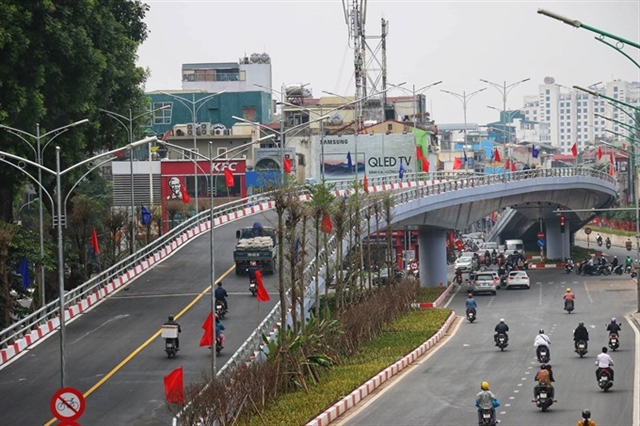 Society
Society


|
| The An Dương-Thanh Niên overpass in Tây Hồ District, one of eight major traffic projects aimed to ease congestion in Hà Nội, was opened to traffic in October 2018. — VNS Photo Đoàn Tùng |
HÀ NỘI — Problems remain in the implementation of Hà Nội’s middle-term public investment plan for the 2016 to 2020 period, vice chairwoman of the city’s People’s Council Phùng Thị Hồng Hà said on Tuesday.
Speaking at a meeting on public investment, Hà said that public investment projects helped address issues of transport, infrastructure, environment and improve living conditions in the city.
However, slow disbursement for public investment projects reduced the efficiency of the State’s capital and land use.
Notably, only nine out of 55 key public investment projects in the city have been completed since 2016.
This year, the city earmarked about VNĐ28 trillion (US$1.2 billion) for 581 projects, Hà said, calling for drastic measures to solve problems and ensure that all funds would be disbursed by the end of the year.
Vice chairman of the city’s People’s Committee Lê Hồng Sơn said that from 2016 to 2019, the city approved a total public investment of over VNĐ107.3 trillion ($4.6 billion), of which, the city earmarked more than VNĐ79 billion for projects.
As much as VNĐ67.49 billion ($2.9 billion), or 85.3 per cent of the arranged funds, were disbursed from 2016 to the end of January 2020.
With the disbursed funding, 396 projects were completed.
In the first seven months of this year, 50 out of 155 city-level basic construction projects were completed, while another 222 projects are ongoing.
By the end of July this year, the city disbursed over VNĐ14.6 trillion ($630.5 million), accounting for nearly 33 per cent of planned funding, Sơn said.
Sơn said that Overseas Development Assistance (ODA) projects were being implemented and disbursed slowly because from 2017, the ODA funding was allocated in line with the State’s yearly plan, not in line with the speed of projects that received the ODA.
Moreover, the ODA funding was from donors and they have to be consulted on the disbursement before selecting bidders.
Difficulties in developing relocation housing hindered land clearance activities, resulting in delayed projects.
Nguyễn Cao Minh, director of the Management Board of Urban Railway Projects, said that it put aside VNĐ5.3 trillion ($229 million) for railway projects in 2019 and 2020.
Until now, just 43 per cent of investment for Urban Railway Line No3 Nhổn – Hà Nội Railway Station was disbursed because of COVID-19, which delayed the import of equipment from Europe.
The Line No3 project will have 97 per cent of funding disbursed by the end of this year, Minh said.
However, for the Urban Railway Line No2 Nam Thăng Long – Trần Hưng Đạo, its funding would not be disbursed this year because changes in the project must be submitted and approved by the National Assembly in its meeting in October 2020.
Nguyễn Văn Hùng, director of the city’s Investment Management Board for Water Supply, Drainage and Environment Works, said that the board was allocated VNĐ1.3 trillion this year but until now, just 42.3 per cent of the funding was disbursed.
“Personnel capacity and investors are key factors affecting the speed of disbursement, but of 186 staff on the board, many fail to meet the job requirements,” Hùng said.
For the Yên Xá waste water treatment project, just 40 per cent of total investment was disbursed because it had to open bidding twice with the first bidding results removed and the second bidding results helping save over VNĐ900 billion.
Chairwoman of Hà Nội People’s Council Nguyễn Thị Bích Ngọc said that the city’s public investment during 2016-2020 was very important to the development of the city and the country as well, because funding for the city’s public investment accounted for ten per cent of the country’s public investment fund.
At this time, public investment would help boost economic growth, support enterprises and create more jobs. — VNS




